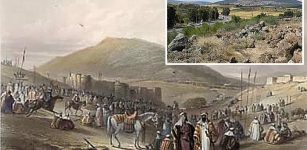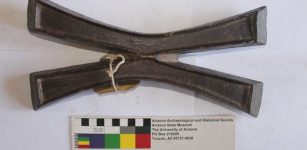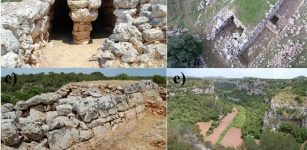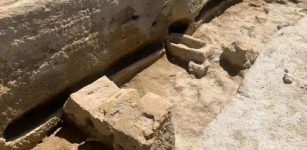Nilometer: Innovative Tool Measuring The Nile’s Water Levels In Pharaonic Egypt
A. Sutherland - AncientPages.com - Since antiquity, the Egyptian civilization has depended on the Nile River, relying heavily on its annual floods for sustenance and prosperity.
Nilometer on the southeast side of Elephantine Island in Aswan, Egypt. Imagec redit: Olaf Tausch - CC BY 3.0
Without the Nile River, the country could not exist. The Nile was the foundation of life, and at the same time, the basis of the ancient Egyptians' religion, work, food production and the calendar.
But the Nile's flooding was unpredictable. High floods could devastate settlements surrounding the river, while low floods reduced or destroyed crop yields and caused diseases.
The Nile: 2.19-34
19. "So said the oracle. Now the Nile, when it overflows, floods not only the Delta, but also the tracts of country on both sides the stream which are thought to belong to Libya and Arabia, in some places reaching to the extent of two days' journey from its banks, in some even exceeding that distance, but in others falling short of it..." (Herodotus)
Therefore, during the Pharaonic Period, the ancient Egyptians employed a systematic approach to measure the Nile's water levels. This method, combined with the use of the nilometer, allowed them to make remarkably accurate predictions about the forthcoming harvest.
Nilometer of Kom Ombo Temple, Egypt. Image credit: Celio Maielo - CC BY-SA 3.0
The nilometer was an ingenious device that was a crucial indicator of the Nile's water levels. Based on current observations, it enabled predictions regarding the forthcoming season's water levels.
The simplest design was a vertical column submerged in the river with marked intervals indicating depth. Another design was a flight of stairs leading into the river.
The nilometer data was then used by the ancient Egyptian priesthood, who ‘mysteriously’ predicted when the flood would occur by monitoring the day-to-day level of the Nile River.
One unique and historic structure is located on Rhoda Island in central Cairo. It was constructed in 861 AD on the exact location of a much older structure of this kind.
Cairo Nilometer - measuring shaft of the Nilometer on Rhoda Island, Cairo. Image credit: Berthold Werner - CC BY-SA 3.0
These water measurement structures continued to be useful until the modern era, when large water storage reservoirs disrupted the Nile's natural flows.
Another historically important nilometer is located on the island of Elephantine in Aswan. In fact, the island Elephantine has two nilometers, each associated with its respective deity and temple.
The two structures exhibit different architectural configurations. Khnum's nilometer was built as a square basin, deviating from the conventional design.
Nilometer on Elephantine Island. Aswan, Egypt. Image credit: Hajor - CC BY-SA 3.0
This is probably one of the most interesting structures on the island and one of the earliest known nilometers used by ancient people. From the entrance, 90 steps lead steeply down to the river, with depth markings along the walls.
Elephantine marked Egypt's southern border and was the first place where the onset of the annual flood was detected. The most elaborate design involved a channel or culvert leading from the riverbank, often running for a considerable distance, and then feeding a well, tank, or cistern.
These nilometer wells were most frequently located within the confines of temples, where only the priests and rulers were allowed access.
In contrast, Satet's nilometer has a much more traditional design. It has a staircase going with measuring holes in its walls, all the way down to the river.
Nilometer on Elephantine Island, Egypt. Image credit: Szabolcs Gebauer
Also, the Edfu Temple complex had once its nilometer. Access to this remarkable structure leads through a subterranean staircase, originating from the eastern side of the Inner Passageway. Currently, it is disconnected from the Nile but the shaft itself still remains visible.
Egypt’s ancient nilometers served people for a very long time, and continued to be used by later civilizations until the 20th century.
The survival and prosperity of the ancient Egyptian civilization were undeniably dependent upon the presence of the Nile River. This majestic watercourse provided the people’s survival and wealth and contributed to the development of a sophisticated society - one of the most influential civilizations in human history.
Today, the nilometers are considered somewhat obsolete. The Aswan Dam primarily aims to regulate the flow of the River Nile, which serves as a lifeline to almost all of Egypt.
Written by – A. Sutherland - AncientPages.com Senior Staff Writer
Copyright © AncientPages.com All rights reserved. This material may not be published, broadcast, rewritten or redistributed in whole or part without the written permission of AncientPages.com
Expand for referencesMore From Ancient Pages
-
 Beautiful And Unique Ancient Roman Hoard Discovered In UK
Archaeology | Oct 3, 2017
Beautiful And Unique Ancient Roman Hoard Discovered In UK
Archaeology | Oct 3, 2017 -
 10 Ancient Chinese Musical Instruments You Didn’t Know About
Featured Stories | Jan 20, 2016
10 Ancient Chinese Musical Instruments You Didn’t Know About
Featured Stories | Jan 20, 2016 -
 Battle Of Himera: New Study That Contradicts Historical Accounts
News | May 24, 2021
Battle Of Himera: New Study That Contradicts Historical Accounts
News | May 24, 2021 -
 Clurichaun – Little Naughty And Drunken Fellow Akin To Leprechaun In Irish Folklore
Featured Stories | Sep 13, 2019
Clurichaun – Little Naughty And Drunken Fellow Akin To Leprechaun In Irish Folklore
Featured Stories | Sep 13, 2019 -
 Abundant Hominin Fossils Dating Back 300,000 Years Excavated In Hualongdong (HLD), East China
Evolution | Aug 7, 2023
Abundant Hominin Fossils Dating Back 300,000 Years Excavated In Hualongdong (HLD), East China
Evolution | Aug 7, 2023 -
 Did Etruscans Solve The Mystery Of Synchronicity And The Secret Language Of The Stars?
Ancient Mysteries | Jul 5, 2018
Did Etruscans Solve The Mystery Of Synchronicity And The Secret Language Of The Stars?
Ancient Mysteries | Jul 5, 2018 -
 Ancient Bronze Age Tomb With Highly Unusual Features – Discovered On Dingle Peninsula, Ireland
Archaeology | Apr 29, 2021
Ancient Bronze Age Tomb With Highly Unusual Features – Discovered On Dingle Peninsula, Ireland
Archaeology | Apr 29, 2021 -
 Lagina Sanctuary Of Goddess Hekate: Archaeologists Found Ceremonial ‘Sacred Road’
Archaeology | Jul 10, 2019
Lagina Sanctuary Of Goddess Hekate: Archaeologists Found Ceremonial ‘Sacred Road’
Archaeology | Jul 10, 2019 -
 Ancient Thriving Market Of Khan al-Tujjar (The Merchants’ Caravanserai) Discovered In Lower Galilee
Archaeology | Feb 20, 2024
Ancient Thriving Market Of Khan al-Tujjar (The Merchants’ Caravanserai) Discovered In Lower Galilee
Archaeology | Feb 20, 2024 -
 America’s First Civilization Was Made Up Of ‘Sophisticated’ Engineers – New Evidence
Archaeology | Sep 2, 2021
America’s First Civilization Was Made Up Of ‘Sophisticated’ Engineers – New Evidence
Archaeology | Sep 2, 2021 -
 Neolithic People Ate Focaccia As Far Back As 9,000 Years Ago
Human Beginnings | Nov 25, 2024
Neolithic People Ate Focaccia As Far Back As 9,000 Years Ago
Human Beginnings | Nov 25, 2024 -
 Ancient Roman Shrine And Over 1,100 Burials Found Beneath The Leicester Cathedral
Archaeology | Mar 7, 2023
Ancient Roman Shrine And Over 1,100 Burials Found Beneath The Leicester Cathedral
Archaeology | Mar 7, 2023 -
 Three Ingots Shed Light On The Mining Exploitation Of The Sierras de Córdoba Mountain Range
Archaeology | May 8, 2024
Three Ingots Shed Light On The Mining Exploitation Of The Sierras de Córdoba Mountain Range
Archaeology | May 8, 2024 -
 Pompey The Great: One Of Roman Empire’s Most Successful Military Commanders
Featured Stories | Jun 14, 2019
Pompey The Great: One Of Roman Empire’s Most Successful Military Commanders
Featured Stories | Jun 14, 2019 -
 10 Ancient Love Symbols
Featured Stories | Mar 2, 2023
10 Ancient Love Symbols
Featured Stories | Mar 2, 2023 -
 Copper Artifacts Reveal New Cultural Connections In Southern Africa
Archaeology | Mar 23, 2023
Copper Artifacts Reveal New Cultural Connections In Southern Africa
Archaeology | Mar 23, 2023 -
 Eating And Social Habits Of People In The Balearic Islands 3,000 Years Ago – Reconstructed
Archaeology | Jan 18, 2023
Eating And Social Habits Of People In The Balearic Islands 3,000 Years Ago – Reconstructed
Archaeology | Jan 18, 2023 -
 Extraordinary Discovery Of First Viking Tower In Viborg, Denmark Re-Writes Viking History
Archaeology | Jan 30, 2017
Extraordinary Discovery Of First Viking Tower In Viborg, Denmark Re-Writes Viking History
Archaeology | Jan 30, 2017 -
 Rare Phoenician Necropolis Discovered In Andalucia, Spain Is Extraordinary, Scientists Say
Archaeology | May 2, 2022
Rare Phoenician Necropolis Discovered In Andalucia, Spain Is Extraordinary, Scientists Say
Archaeology | May 2, 2022 -
 Mystery Of Ancient Sami People Buried Underwater – New DNA Breakthrough
Archaeology | Jun 12, 2019
Mystery Of Ancient Sami People Buried Underwater – New DNA Breakthrough
Archaeology | Jun 12, 2019





